Built to Last
As NUS strives to create a smarter, safer and more sustainable campus, The AlumNUS looks at the thinking behind the spirit of continuous evolution on Kent Ridge and speaks to some of those who are helping to make this happen.
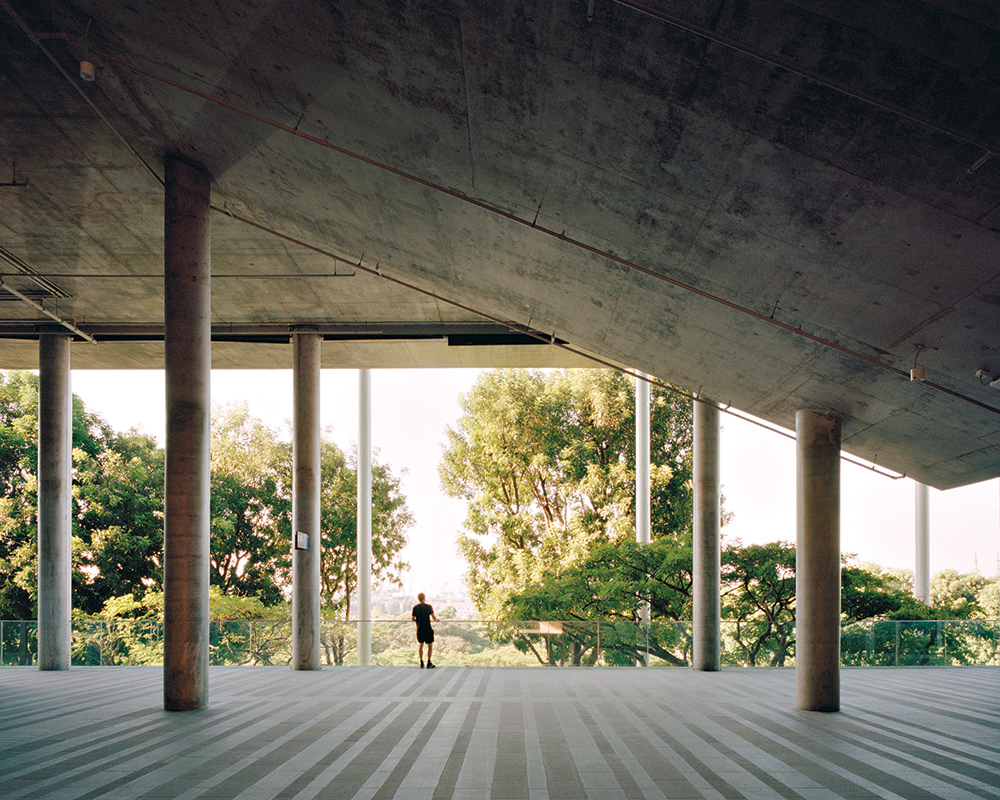 A view from the School of Design and Environment’s SDE4 building, a significant example of sustainable design here. Singapore’s first new-build net-zero energy building, it functions as a living laboratory to showcase and testbed innovative solutions in sustainable development.
A view from the School of Design and Environment’s SDE4 building, a significant example of sustainable design here. Singapore’s first new-build net-zero energy building, it functions as a living laboratory to showcase and testbed innovative solutions in sustainable development.
Nowadays, the idea of having a driverless shuttle bus on the road is not a matter of ‘if’ but ‘when’. At NUS, that moment may come as soon as this May. The University is partnering transport company ComfortDelGro in a year-long trial of an autonomous shuttle bus, which will travel along a 1.6km route between Heng Mui Keng Terrace and Business Link at the main Kent Ridge campus.
Powered by artificial intelligence, the self-driving shuttle bus is an excellent example of how smart technologies are revolutionising transport. The autonomous vehicle will initially focus on collecting data for its mapping and navigation systems, and will start taking passengers only after it is deemed safe. Because it runs entirely on electricity, the shuttle — which may eventually be rolled out as a commercial service — could also substantially reduce carbon emissions and improve environmental sustainability.
The soon-to-be-introduced autonomous shuttle bus is but one small indication of the changes that have taken place at NUS during the 2010s, as it inches closer to becoming a ‘Smart, Safe and Sustainable (S3) Campus’. This is the most recent phase of a transformation journey that began back in 1973, when NUS first commenced construction work at the Kent Ridge site. Guided by its S3 Campus mission, the University is modernising its infrastructure, physical and otherwise — and in turn, engaging and empowering the NUS community.
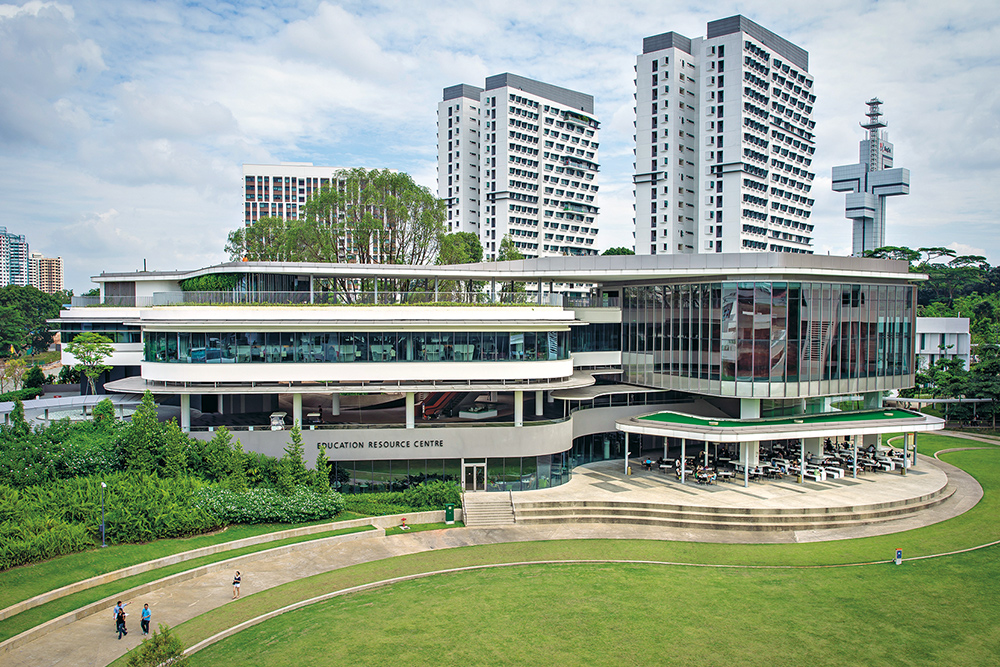 UTown’s Education Resource Centre (ERC) overlooking the Town Green
UTown’s Education Resource Centre (ERC) overlooking the Town Green
THE TESTBED OF CHANGE
Many of the changes currently happening at NUS’ Kent Ridge campus were birthed in the adjacent University Town (UTown), which welcomed its pioneer batch of residents in August 2011. “UTown gave us an opportunity to create an integrated campus that combines learning and living, and to test new pedagogical methods like discovery-based learning and the flipped classroom approach,” says Professor Yong Kwet Yew, Senior Vice President (Campus Infrastructure) of NUS. “Our tagline was, ‘Our classrooms are everywhere.’”
Mr Koh Yan Leng (Engineering ’99), Associate Vice President (Campus Life) of NUS, adds that UTown’s distinctive learning-and-living model reflects the shifting expectations students have about residential life. “Today, the majority of students staying on campus are locals rather than foreigners. They are drawn here not because they are simply looking for accommodation, but out of a desire for a fuller campus experience. They want to be part of a ‘home’ or community at NUS, where they can connect with other students and build their leadership and networking skills.”
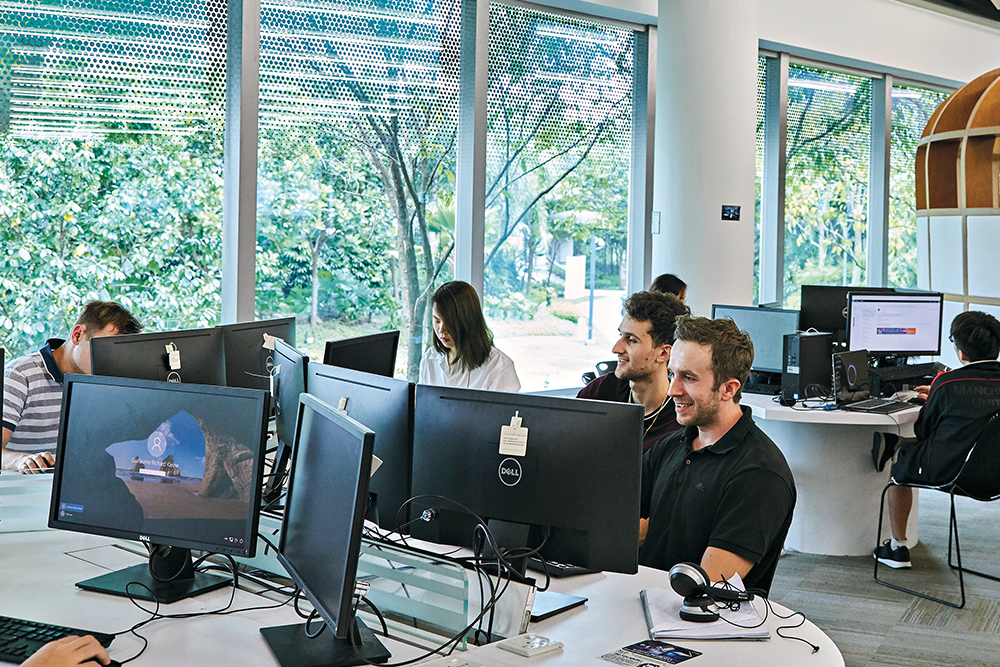 The Computer Commons located at the ERC, where students can work on presentations individually or in groups using high-end computers
The Computer Commons located at the ERC, where students can work on presentations individually or in groups using high-end computers
This community vibe is evident throughout UTown. Within the residential colleges, students congregate in common lounges and multi-purpose halls for formal learning activities, casual chats, parties and other events. Located near the residential colleges are a variety of learning and recreational amenities. The Education Resource Centre offers a 24/7 collaborative space for project teams at the Computer Commons, as well as seminar rooms with modular furniture to facilitate small-group discussions. Outside, the Town Green attracts students taking a break from their studies to relax with friends.
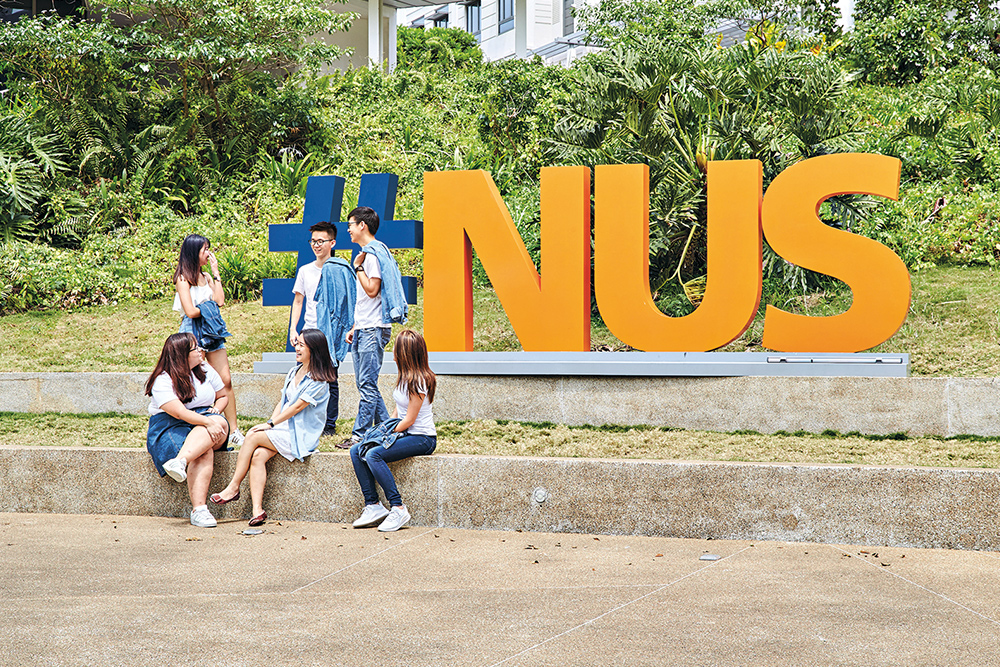 The Town Green, a popular hangout spot among students.
The Town Green, a popular hangout spot among students.
UTown also presented an opportunity for NUS to apply novel, environmentally-sustainable design principles for the first time. The development is built around existing trees, most notably the Margaritaria indica tree at Yale-NUS College that has been gazetted as a Heritage Tree by the National Parks Board. To improve natural ventilation in buildings, large ceiling fans were installed and computational fluid dynamics (CFD) modelling was used for wind-flow simulations. Due to these and other environmentally-friendly practices, UTown has won several Building and Construction Authority (BCA) Green Mark awards, including the inaugural BCA Green Mark for Districts award, as well as international architectural design awards.
DID YOU KNOW?
On 23 November 2018, NUS launched its “Planting 10,000 Trees” initiative. A total of 10,000 trees will be planted throughout the campus. The trees are expected to lower the surrounding temperatures by 1°C, as well as sequester 220 tonnes of carbon dioxide and produce nearly 1,200 tonnes of oxygen annually.
A CAMPUS-WIDE REVAMP
Taking a leaf out of UTown’s book, the University has been implementing these same measures to rejuvenate its Kent Ridge campus. “When Kent Ridge was first established in the 1970s, the various NUS faculties — hitherto scattered across four sites island-wide — were re-located to one campus, but they remained in separate, entrenched silos. We are now redeveloping Kent Ridge into a well-integrated, greener campus,” explains Prof Yong.
Some of these projects have already been completed. Launched in 2014, the Ventus building (occupied by University Campus Infrastructure staff), for instance, is built around existing Tembusu and rain trees, and has a green roof and walls. In 2016, NUS Enterprise opened a start-up facility called The Hangar at iCube, which is within walking distance of ENterprise House, an entrepreneurial-themed residence. At the revamped Science canteen, Frontier, which started operations in 2017, a mix of dining options, study clusters, student club offices as well as interactive spaces allow students to eat, learn and mingle — all in the same spot.
Similar plans are in the works at the NUS Engineering canteen, which is currently being redeveloped, while the Business and Computing canteen is also slated for redevelopment (together with a new School of Computing building). Among the design options being considered for the latter are multimedia-equipped discussion pods where students can work on their presentations, as well as a central stage with a big screen for hosting e-sports competitions, concerts and other events. “We intend to make a bold change to the traditional canteen concept and make the space more usable all day long, not just during lunchtime,” says Mr Koh.
One of the most striking buildings at Kent Ridge is the Lee Kong Chian Natural History Museum, which was officially opened in 2015. Its boulder-like structure and vertical greenery convey a sense of the natural world. According to the Museum Head Professor Peter Ng (Science ’83), the campus-wide ‘greening’ push is a way of making the area more beautiful and pleasant, as well as restoring our lost natural heritage.
“Because of NUS’ hilly terrain, parts of the campus are difficult to build on, so those areas have been left untouched,” says Prof Ng, a conservation biologist. He is especially heartened by the University’s focus on enhancing native biodiversity. “We should preserve what is important to the heritage of our country, including animal and plant species that are indigenous to Singapore.”
ABOUT THE RIDGE
This spotted wood owl, recognised as a ‘critically endangered’ species in Singapore, was sighted at the Kent Ridge campus in March 2015. The photo appears in Kent Ridge: An Untold Story (NUS Press, 2019), an edited volume by NUS Law Adjunct Professor Kevin Tan (Law ’86). It traces the history of Kent Ridge back to the early 19th century, during which the land changed hands several times before it was finally secured by the University in 1968. The book also features the rich flora and fauna that can be found here.
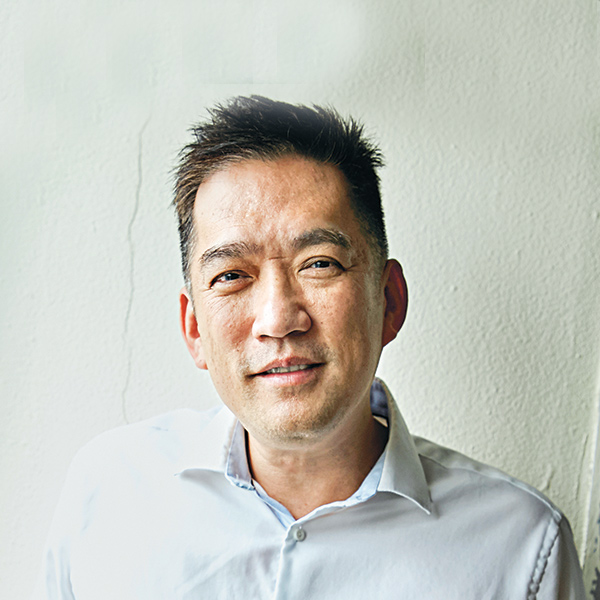
Technology can change the way we live, learn, work and play. At NUS, we offer a playground for people to see and build upon these possibilities, which will lead to more productive, happier lives.
Prof Andrew Lim, Head, Department of Industrial Systems Engineering and Management, NUS
ON SMART GROUND
Next in line for a makeover at NUS is the Science–Medicine precinct. A brand new Wet Science Building is set to open by the end of this year, bringing together all wet laboratory researchers under one roof for cutting-edge biomedical research on nanoparticles, graphene sheets and other materials. The building will link up with Frontier to frame an Academic Green — not unlike the Town Green at UTown — to encourage interactions and create breathing space in the heavily-congested area.
To help visualise the new Science–Medicine precinct, University planners are turning to a smart technology called Virtual NUS, a 3D digital twin of the Kent Ridge campus. Developed in-house using drone imagery and data, the virtual model can do more than run simulations to test design ideas for future buildings — it collects real-time data from campus WiFi hotspots (including shuttle buses), thus enabling users to conduct data analytics and make more judicious decisions about campus infrastructure.
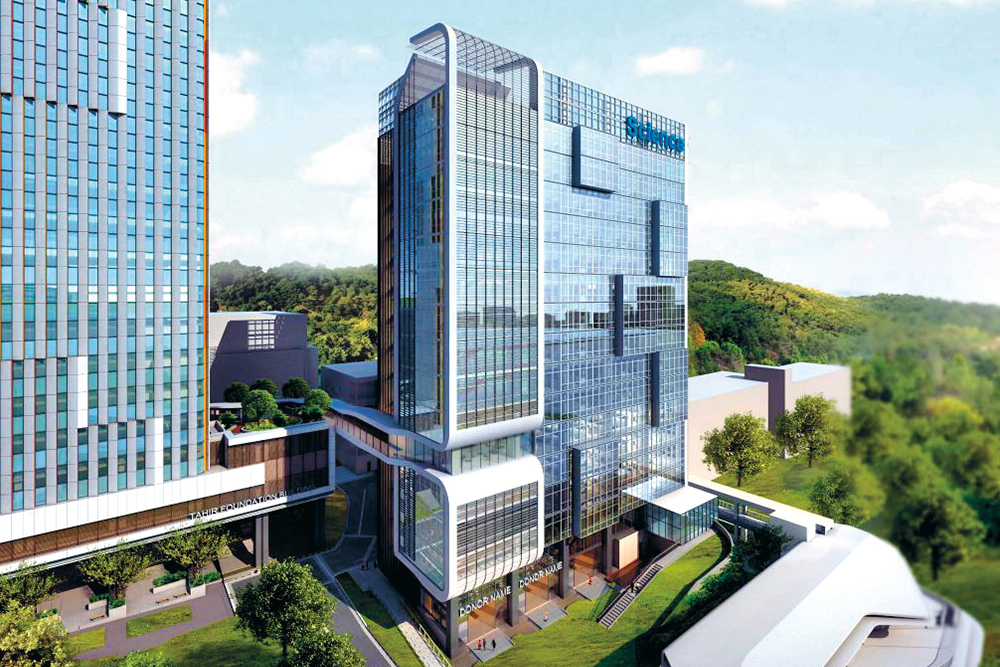 An artist’s impression of the Wet Science Building.
An artist’s impression of the Wet Science Building.
For example, the 3D model can estimate the solar potential of building rooftops and perform computational fluid dynamics (CFD) simulations of wind flow, so as to improve the energy-efficiency of buildings. Virtual NUS’ crowd-sensing capability can help users determine which lecture theatres are under-utilised, and hence suitable for repurposing into modern learning environments such as smaller tutorial rooms, makerspaces or social hubs. It can also track the number of commuters on shuttle buses to optimise bus schedules and routes.
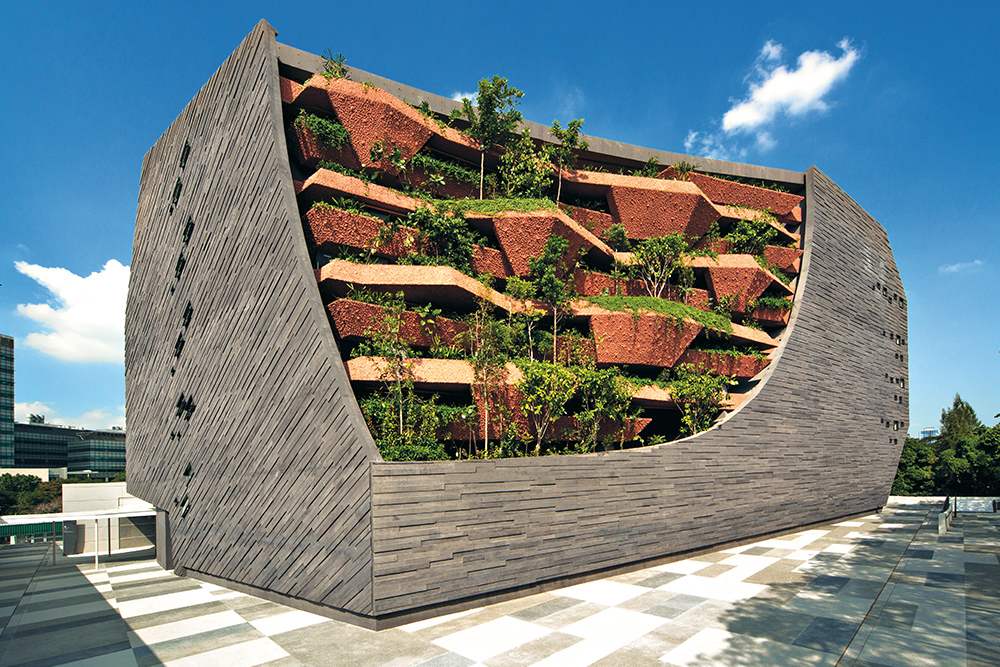 NUS’ Lee Kong Chian Natural History Museum.
NUS’ Lee Kong Chian Natural History Museum.
APP-TASTIC! 
Here are some mobile apps that have made life easier for those studying and working at the University:
NUS NextBus
Users can get up-to-the-minute bus schedules, along with detailed maps of bus stop locations and their current location on campus.
NUSmart Dining
Currently being trialled at Frontier, it helps diners avoid long queues by letting them pre-order their food and notifying them when it is ready for pick-up. They can also pay using their preferred e-wallet.
NUS Maps
This app offers 3D outdoor and indoor (room-to-room) navigation to help users find their way around Kent Ridge and UTown.
NUS Alert
As NUS’ emergency mass notification system, it provides immediate and vital emergency information, as well as urgent advisories, about NUS.
NUS Suite
With a single log-in, this all-in-one platform allows users to customise and access all NUS apps submitted by third-party developers (including students).
Professor Andrew Lim, Head of NUS’ Department of Industrial Systems Engineering and Management, is the Director of Virtual NUS. This programme falls under the NUS Smart Nation Research Cluster and is housed in the Innovation4.0 building, which opened its doors in September 2018. Indeed, NUS is particularly well-suited to carry out such innovative projects and support Singapore’s Smart Nation agenda. “With more than 200 buildings and some 50,000 students and staff, the NUS community is sizeable yet self-contained. That makes us a safe testbed or ‘sandbox’ to experiment with cutting-edge technologies, as we can resolve any problems before the impacts are felt by the public,” explains Prof Lim, who adds that researchers are not the only ones pushing the technology envelope. “Students can create and test their mobile apps within NUS. If feasible, they can then roll out their ideas into the bigger marketplace.”
Ultimately, he believes that all Singaporeans stand to benefit from the smart initiatives being piloted at NUS. “Technology can change the way we live, learn, work and play. At NUS, we offer a playground for people to see and build upon these possibilities, which will lead to more productive, happier lives.”
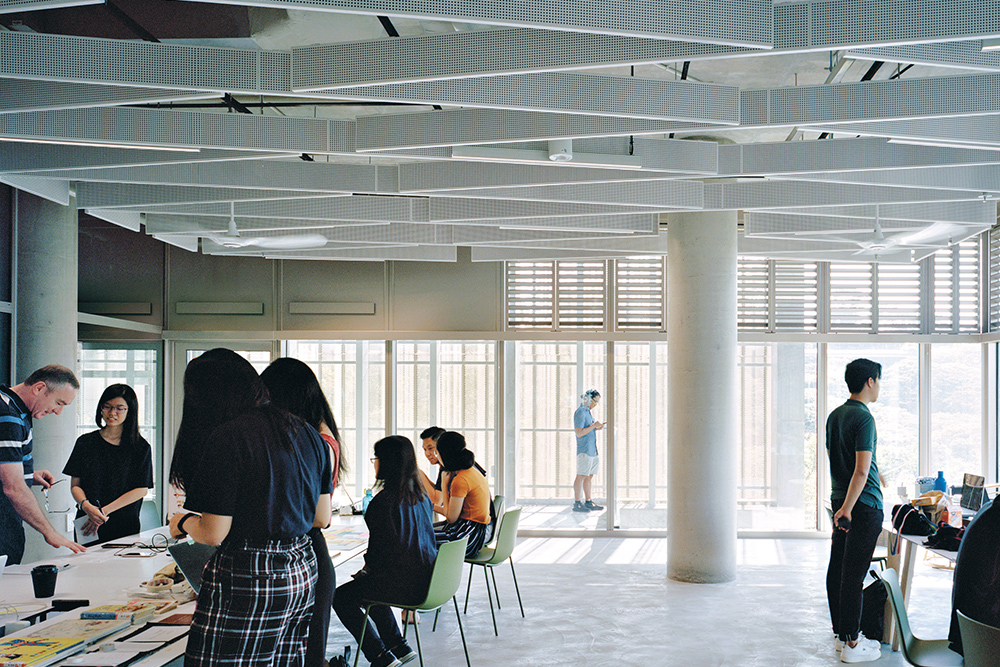
GOING GREEN
The newest building at Kent Ridge is the NUS School of Design and Environment’s SDE4, which was unveiled on 30 January. Widely acclaimed as Singapore’s first new-build net-zero energy building, SDE4 is designed to consume only as much energy as it creates. This is achieved through myriad green architecture elements including rooftop solar panels, a hybrid cooling system which employs air-conditioning units and ceiling fans, and a large overhanging roof to shade occupants from the tropical sun, as well as other methods to optimise natural ventilation and lighting.
SDE4 functions as a living laboratory to showcase and testbed innovative solutions in sustainable development. For example, located within SDE4 is the NUS–CDL Smart Green Home, where emerging big data technologies will be explored for their eventual use in residential developments in Singapore. Sections of the building façade can even be dismantled and replaced with new wall prototypes to analyse their performance.
Dr Christopher Lee (Architecture ’95), co-founder and Principal of Serie Architects, served as the lead architect of the SDE4 project, thus adding an extra dose of pride to this feat. “SDE is one of the rare examples where the architecture school ‘walks the talk’,” says Dr Lee. “The conceptualisation and construction of a new faculty building offers an opportunity to test existing theoretical knowledge within the school, as well as generate new knowledge at the end of the process. In this way, the architecture of the new building is both pedagogical and demonstrative.”
One of SDE4’s most telling contributions is that it advances a new way of thinking about sustainability and well-being. “In the past, discussions have been overwhelmingly technical and preoccupied with indoor air quality,” says SDE’s Associate Professor Nirmal Tulsidas Kishnani (Architecture ’88). “SDE4 has expanded the discussion to encompass biophilic design, a human-centric concept emphasising connectivity to nature. Instead of being cooped up in a glass box, SDE4 users are encouraged to step outdoors and be a part of the landscape.”
Thanks partly to SDE4’s sustainable design practices, the University is on track to reaching the targets laid out in its Sustainability Strategic Plan 2017–2020. This ambitious roadmap involves the whole community — from campus planners in charge of NUS’ physical infrastructure, to students taking sustainability-related modules and joining environmental CCAs. “We want to be a responsible and progressive university that minimises its carbon footprint, while still fulfilling our research, educational and public service goals,” says Ms Amy Ho (Business ’06), Director of the NUS Office of Environmental Sustainability. “Hopefully, what we do on campus will plant the seeds for the NUS community to embark on their own sustainability initiatives.”
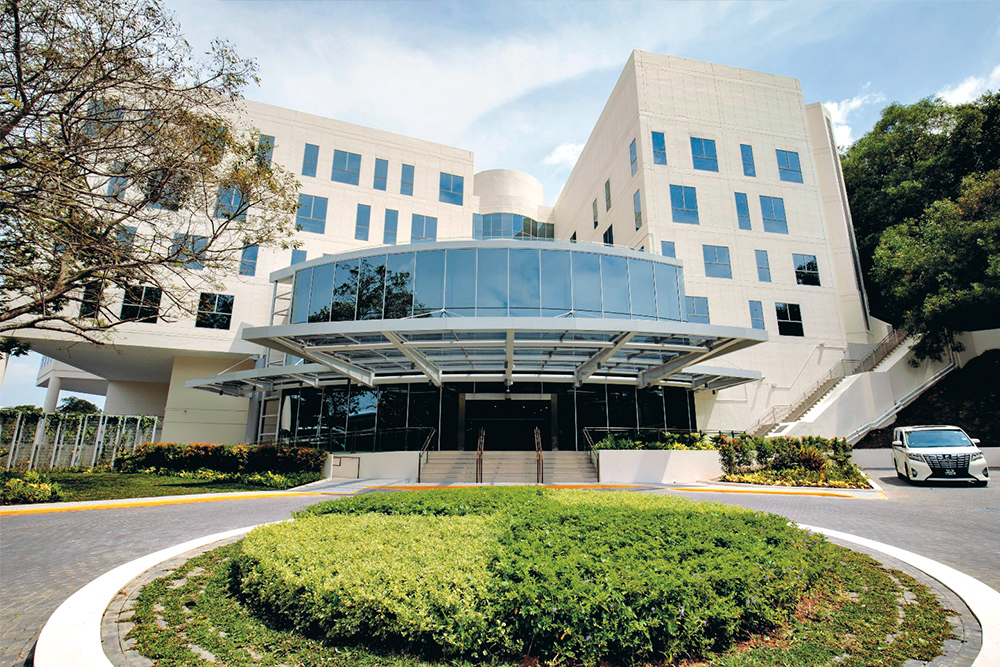 The Innovation4.0 building.
The Innovation4.0 building.
SAFETY FIRST
Another aspect of campus operations that is being transformed by Virtual NUS is campus safety and security. The old approach of staring at monitors and responding to incidents will soon become outdated, as the NUS Office of Campus Security (OCS) gets ready to open its new Command Centre in the next few months. “It will be a ‘smart’ nerve centre that pulls together information from all of our security measures — campus patrol officers, CCTV cameras, access control systems, etc. — to help us do our job more effectively and efficiently,” says Mr Keith It (Business ’98), Director Designate of OCS.
Integrating these subsystems onto a common platform will give OCS staff a visual appreciation of site plans and building layouts, so they can figure out where best to position CCTV cameras, bollards, thick shrubs as natural deterrents, and the like. Real-time data will also be useful in improving resource deployment, and to identify the exact location of security officers so as to dispatch the closest one to the scene. However, Mr It stresses that maintaining campus security is the responsibility of the entire NUS community, although
many often take it for granted. “While our work is focused on ensuring a safe campus, we don’t want the community to be complacent either. We will work with them because everyone has a part to play in campus security.”
Spurred by the launch of the national SGSecure movement in 2016, emphasis is now being placed on community preparedness to fend off terrorism — and University students are taking the lead on this, not just within NUS but across the island. The NUS Civil Defence Lionhearter Club is a student interest group whose members are trained by the Singapore Civil Defence Force in basic first aid, basic firefighting, as well as cardiopulmonary resuscitation and automated external defibrillator procedures. They impart these life-saving skills to others at events held on campus and in the heartlands.
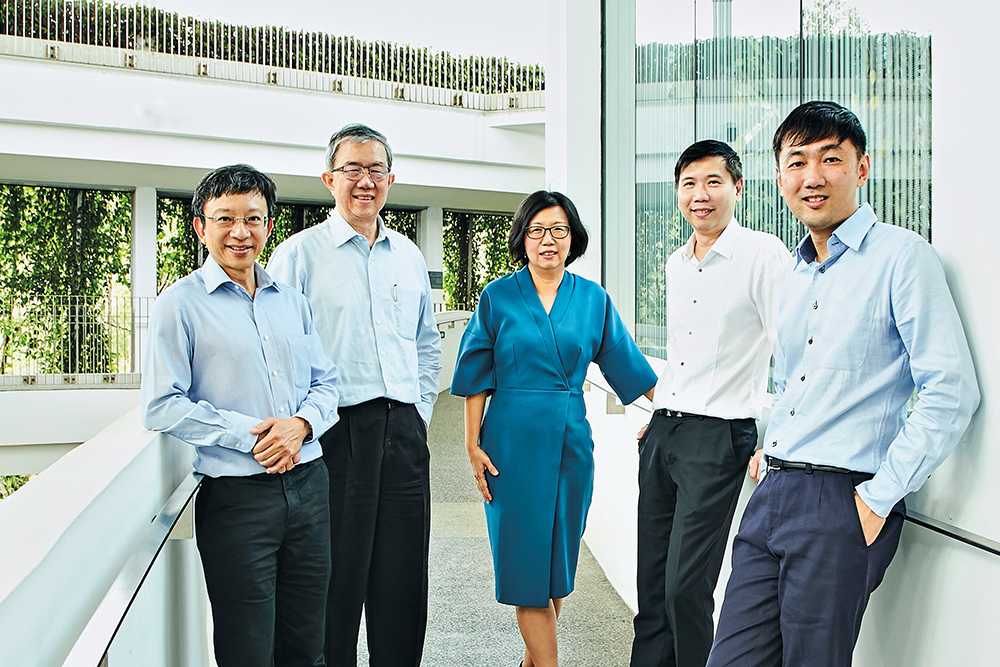 From the University Campus Infrastructure offices (left to right): Dr Peck Thian Guan, Prof Yong Kwet Yew, Ms Amy Ho, Mr Koh Yan Leng, and Mr Keith It.
From the University Campus Infrastructure offices (left to right): Dr Peck Thian Guan, Prof Yong Kwet Yew, Ms Amy Ho, Mr Koh Yan Leng, and Mr Keith It.
These student-led efforts supplement the work done by the NUS Office of Safety, Health and Environment (OSHE) to promote total workplace safety and health. OSHE staff engage the various faculties, halls and residential colleges all year round through lab safety training workshops, safety and health advisories and consultations, inspections, vetting of student-drawn safety and crisis management plans for co-curricular activities (CCAs), simulated terror attacks and fire drills, as well as faculty-specific Safety Day events.
“We want to grow a safety and health culture among the NUS community, and encourage individual ownership of safety and health. By embracing this mentality, our students can in turn exert a positive influence on other people once they join the workforce,” says Dr Peck Thian Guan (Science ’87), Director
of OSHE.

“In the last two financial years, NUS reduced its electricity consumption by 7 million kWh ($1.12 million), despite an increase in gross floor area of over 40,000 m2. Chiller plant and air change optimisation in laboratories have been the major energy-saving projects implemented during this period.”
Mr Chew Chin Huat (Engineering ’90), Senior Director (Campus Operations and Maintenance) of NUS
RAISE YOUR VOICE
NUS, like all universities, is a living, breathing entity. There is no telling what the Kent Ridge of tomorrow will look like. However, Prof Yong has a rough idea: “While upgrading our infrastructure, we should still preserve some old buildings to showcase how our campus architecture has changed over the years. We have to learn from the past in order to build for the future.”
In this endeavour, NUS alumni can provide the most valuable input. “We hope to continue to do more with and for alumni, by getting them to share their memories of what they miss about the University. Preserving buildings and spaces that hold special meaning for our alumni will make them want to keep coming back, and also help future generations remember the University’s history,” says Prof Yong.
Special thanks to Ms Geraldine Lee, Director, Community Engagement & Development, NUS Campus Infrastructure, for her inputs and assistance in the writing of this article.
Text by Wanda Tan